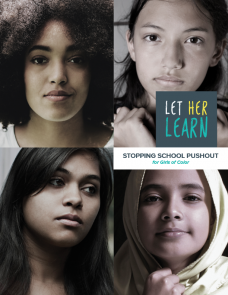By Kenrya Rankin
ColorLines, April 19, 2017 —

Photo: EvelynGiggles via Flickr Creative Commons
The National Women’s Law Center’s latest report explores how trauma impacts the trajectories of
Asian American and Pacific Islander, Black, Latinx and Native American girls.
A new study from the National Women’s Law Center (NWLC) explores the barriers that stand between girls of color and their education.

Released today (April 19), “Stopping School Pushout For: Girls of Color” is in one in a series of seven reports crafted using data from the organization’s national “Let Her Learn” survey of 1,003 girls ages 14 to 18 conducted in January. The survey asked participants about their lives in several areas, including their exposure to sexual violence, their proximity to immigration issues and their experiences with law enforcement. Researchers also examined existing data for trends.
Here are the key points from the report, as outlined in a statement posted by NWLC.
- Nearly 1 in 5 Black girls (19 percent) and LGBTQ girls (18 percent) reported experiencing homelessness.
- More than half of Latina girls (55 percent) said they are worried that a friend or family member will be deported.
- Almost a quarter of Latina girls (24 percent) reported being harassed because of their name or family’s origin.
- Nearly half of Asian and Pacific Islander girls (46 percent) reported being called a racial slur—higher than any other group of girls.
- Black girls are 5.5 times more likely to be suspended from school than White girls.
- Black girls are 6.1 times more likely than White girls to be expelled from school and 2.5 times more likely to be expelled without educational services for the rest of the year.
- Black girls with disabilities are 3.5 times more likely to be suspended than White girls with disabilities.
- Almost half (47 percent) of high schools with 90 percent or more students of color have at least one law enforcement officer, compared to just under a third (31 percent) of high schools with 90 percent or more White students.
“These reports and data should sound an urgent alarm for policymakers, educators and communities,” Neena Chaudhry, NWLC’s director of education, said in a statement. “The trauma that so many girls of color experience affects not only their mental and physical health but also their ability to concentrate, feel safe, and stay and do well in school. And yet our survey also showed that, despite the barriers they face, girls of color are resilient and want to succeed and go on to college. We need targeted policies to help these girls stay and thrive in school.”
The report concludes with recommendations for policymakers, educators, parents and advocates to help girls surmount these barriers. Head to LetHerLearn.org to join the fight.
Other reports cover the lived experiences of girls with disabilities, those with children, those who are experiencing homelessness, those who identify as LGBTQ and more. Access them all here.









